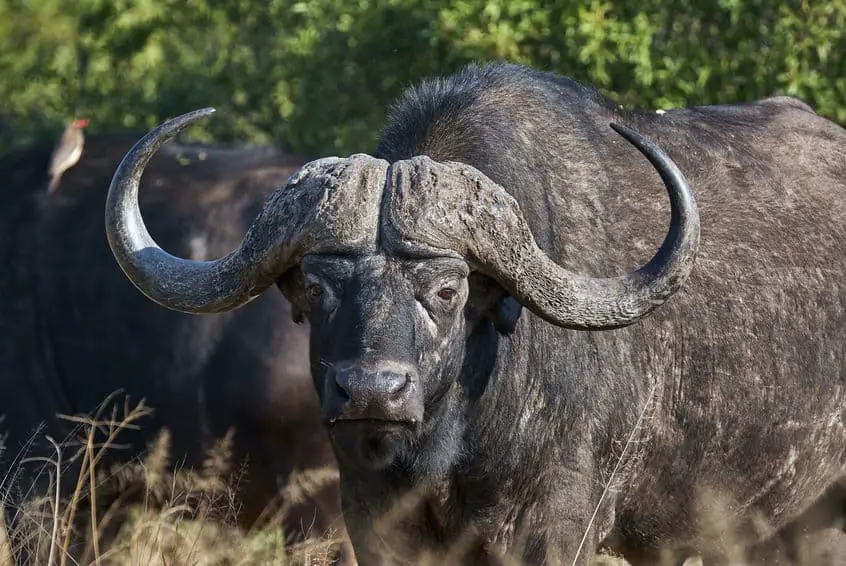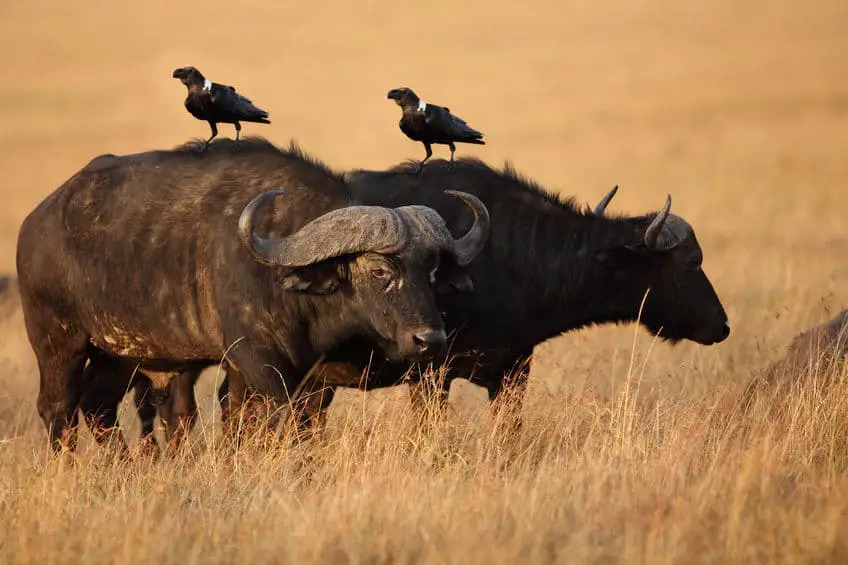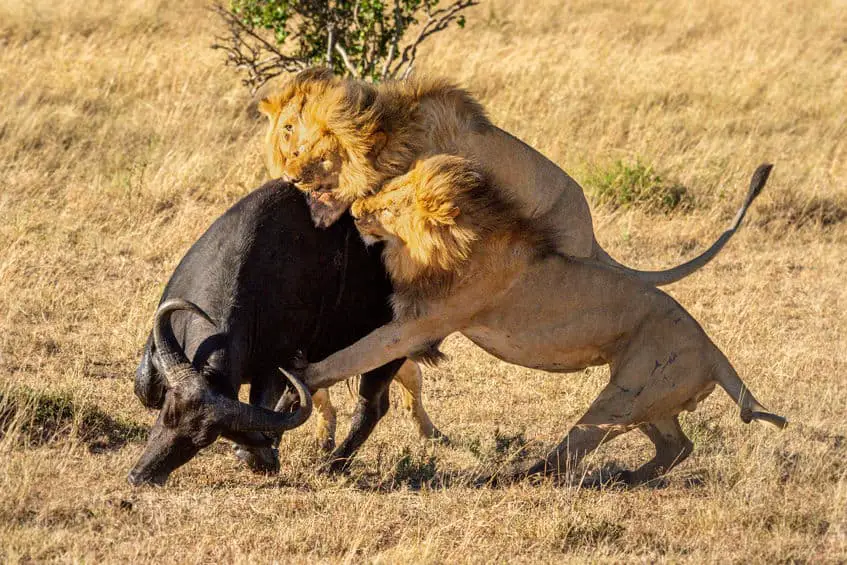
You may have heard people refer to Cape buffalos as Black Death or Widowmakers and that is absolutely a name they deserve, but what exactly is it that makes Cape buffalos so dangerous?
Cape buffalos are often referred to as Black Death since they are extremely dangerous to both humans and other animals. Cape buffalos are thought to be responsible for killing 200 people per year. Once a Cape buffalo is charging, it is determined to kill its target and is almost impossible to stop.
Cape buffalos are both aggressive and extremely unpredictable in their behavior and once they have decided to attack, the outcome of the fight is often already determined. Below, I have described the things that truly make Cape buffalos worthy of the name Black Death.
The Most Dangerous of the Big Five
The African Buffalo, or Cape buffalo, is widely considered to be the most dangerous member of the big five, which is a group of African animals that includes Cape buffalo, elephant, leopard, lion, and rhinoceros.
The big five got their name by being widely perceived as being the most dangerous and also the most prestigious big game animals to hunt so being the most dangerous in such a group, makes the Cape buffalo not only one of the most dangerous animals in Africa but also in the entire world.
In fact, the Cape buffalo is so dangerous that it is often referred to by the truly terrifying names the Black Death and the Widowmaker.
It is absolutely no joke when the Cape buffalo is referred to with these horrifying names as it is believed to be responsible for more human deaths than any other mammal in Africa.
It is difficult to determine which animal is responsible for most fatal incidents with certainty and hippos and crocodiles are also responsible for many, but what is 100% certain, however, is that the Cape buffalo is up there and should not be messed with.
Some of the characteristics and qualities that make the Cape buffalo so dangerous and worthy of the name Black Death is that it is a massive and extremely strong animal. It has long, incredibly strong, and very pointy horns which it uses to impale and gore enemies.
The horns on a male Cape buffalo (called a bull) are connected in the middle and create a thick and extremely hard and protective layer that almost works as a shield across the forehead that protects this critical area of the bull’s head.
This rockhard protective layer where the horns are connected is called a boss.
A female Cape buffalo (called a cow) does not have a boss between the horns, mainly because it is simply not as needed for the cows as for the bulls. The primary reason why it is an important feature for the bulls is that they often have individual fights where they go head to head in the most literal sense of the words, where they will charge with full speed towards each other and bang their heads together. I will get more in-depth with this later in this post.
Perhaps the quality that makes the Cape buffalo more dangerous than any other member of the big five is its personality. The Cape buffalo expresses an unpredictable and extremely aggressive personality and can appear and behave grumpy and fierce.
When wounded or when a calf or a weak member of the herd is under attack is when the Cape buffalo is the most aggressive and it will not hesitate to attack and go for the kill and it does not matter if the attacker is a human or a lion or anything else for that matter.
Cape Buffalos Kill Over 200 People per Year in Africa

The Cape buffalo is said to have killed more people than any other member of the big five and most of its victims have been big game hunters hoping to bring home a trophy.
It might be natural to think that an animal as large as the Cape buffalo would be easy to spot from a distance and thereby avoid a clash by getting to safety in time but unfortunately, that is not the case.
The Cape buffalo is largely dependent on water and the ideal habitat is one that contains a lot of it and as a result of that, also a lot of vegetation and tall grass.
Tall grass and dense vegetation allow the Cape buffalo to be easily camouflaged and to move around without getting noticed very easily so when a hunter notices it, it is often already much too late.
When hurt, a Cape buffalo can often attempt to sneak around the unsuspecting hunter and attack by charging at them from behind at which point it is almost certainly too late for the hunter to escape. A charging Cape buffalo is close to unstoppable and once it has started charging, it means it is going for the kill.
When One Cape Buffalo Attacks, the Rest Will Follow
At this point, a single Cape buffalo might seem plenty scary but one thing that makes them much more frightening and dangerous is the fact that they are very social creatures and will mostly stay in groups of 10-20 animals.
During the mating season and especially on long wanderings, Cape buffalos will sometimes form massive herds with several thousand animals moving together. These unbelievably massive herds are an incredible sight and watching thousands of Cape buffalos moving as one massive unit is truly magical.
Being the highly social creatures that they are, Cape buffalos will almost always assist each other if one of the members of the herd gets into trouble. They will do their best to protect another Cape buffalo that is under attack. Once a member of a herd of Cape buffalos attacks, the rest will usually follow and attack as well.
Cape buffalos are very good at coordinating their attacks with each other and will often surround their enemies.
You can see that behavior in this famous footage rightfully named Battle at Kruger where a pride of lions manage to catch a Cape buffalo calf but quickly are surrounded by the rest of the herd. The footage was posted in 2007 so naturally, the image quality is a bit grainy but the footage itself is truly unbelievable.
In this footage, you can clearly see that Cape buffalos will try to protect each other and work together in fighting against enemies, which in this case (and in most cases) are lions.
Cape Buffalos are Huge
I have already briefly mentioned that Cape buffalos are very large animals which makes them even more dangerous and terrifying but let us get some numbers on the table to determine just how large these aggressive and unpredictable animals are.
Cape buffalo bulls weigh between 1100-2000 lb (around 500-900 kg) and the females weigh between 770-1370 lb (around 350-620 kg).
Cape buffalos are not only extremely large and heavy animals but they are also built in a way that makes them extremely dense and bulky and completely immovable by most other animals.
Their massive size and weight also make them completely unstoppable for almost any animal (including humans) when they decide to charge so anybody who appreciates being alive better stay out of the way of Cape buffalos and avoid attacks at all cost.
Cape Buffalos do Not Mock Charge
Some animals can do what is called a mock charge. A mock charge is when an animal expresses behavior that would make other animals expect it to charge towards them. A mock charging animal will initiate a charge and often even start to charge towards its target but then stop before reaching it.
A large African mammal, and fellow member of the big five, that often mock charges is the elephant. It does so to attempt to intimidate and scare its target.
Cape buffalos do not have a mock charge so do not expect them to stop once they have started charging. Once a Cape buffalo has begun to charge, it means that it is determined to attack and kill its target.
A charging Cape buffalo can reach speeds of 35 mph (around 56 km/h) and is completely impossible to stop for almost anybody.
They Can Wait for Hours to Get Revenge
If by some miracle a hunter manages to escape an attacking Cape buffalo, it will almost certainly be by climbing high up into a tree before the Cape buffalo reaches him or her.
If the hunter is extremely lucky and swift and manages to make it to safety by climbing up into a tree, he or she better be armed with a good amount of patience.
Cape buffalos are known to have the patience to wait underneath a tree for several hours so they can get revenge on a hunter that may have attempted to shoot at them or have otherwise made himself or herself be perceived as a threat or an enemy to the Cape buffalo.
Cape buffalos will simply not give up and once they have decided that a person or a predator is an enemy, it will neither forget nor forgive it.
Even Cape Buffalos have Natural Enemies

With their massive size, their incredible strength, and their dangerous set of large and pointy horns, the Cape buffalo poses a threat to any predator that decides to take a shot at attacking it.
Most predators are simply not large or strong enough to even attempt to take up a fight with a Cape buffalo but lions, who are significantly larger than the other big cats of Africa and also has the advantage of hunting as a group, will often take their chances and hunt Cape buffalos.
In fact, Cape buffalos and lions are two sides of one of the oldest and most fierce rivalries in Africa.
The Battle at Kruger-video from earlier in this article is a great example of just how daunting and intense this rivalry can get.
Cape buffalos are much larger and stronger than lions and a single Cape buffalo will overpower and kill a single lion without a problem in almost every single case.
Cape buffalos are thought to be responsible for more lion deaths than any other animal in Africa.
If a pride of lions has taken down a Cape buffalo, the rest of the Cape buffalo’s herd will often come back and take revenge on the lions and try to kill as many of them as possible.
Cape buffalos have even been seen systematically seeking out and killing lion cubs. The reason why they do this seems to be to reduce the threat and future competition from lions. This suggests an impressive (but frightening) intelligence in Cape buffalos.
Cape buffalos are so strong that they can easily and effortlessly toss lions several meters through the air and they will try to kill the lions by impaling them with their horns.
The rivalry is not at all as one-sided as it may seem though as lions can absolutely pose a huge threat to Cape buffalos.
One of the biggest advantages lions have when they hunt is that they hunt in groups most of the time.
On their own, lions can take down large herbivores like zebras and wildebeests but as a group, they can take down animals up to 10 times larger than themselves including white rhinoceroses, hippos, young elephants, giraffes, and fully grown Cape buffalos.
When hunting Cape buffalos, a pride of lions will often target calves or old or otherwise weak animals as these pose less of a threat and are easier to overpower. Most of the time, the lions will wait for a Cape buffalo to get separated from the rest of the herd so they can attack without too much resistance.
When fully grown, Cape buffalos’ ribs are extremely thick and dense and are placed very close to each other so they are difficult for the lions to get through as they work almost like armor.
Because Cape buffalos are both dangerous and difficult to take down, lions prefer to hunt for other prey that is easier to take down.
What lions hunt depends largely on their territory and what prey animals are in their territory. In some parts of Africa, Cape buffalos are actually a very important source of food for the lions.
Cape Buffalos Also Fight With Each Other
The rivalry does not stop with lions. Cape buffalo bulls are also often seen fighting among each other.
They do this to establish dominance and determine which of the bulls is the strongest.
When fighting, two bulls will circle each other and attempt to intimidate their opponent but if none of the bulls back down, they will start backing up and then charge directly towards each other at full speed and bang their massively thick and strong horns and foreheads against each other.
These bull-on-bull fights can be so intense and full of force that the weaker bull can sometimes be thrown several meters through the air. Remember, we’re talking about animals that weigh more than a thousand pounds. That takes some serious strength.
As mentioned, these fights are a way to determine which of the bulls is the strongest and the winner will have a higher place in the hierarchy of the herd and will attract more females.
If you liked this article and are interested in reading more about the Cape buffalo, follow this link which will take you to all our posts about the Cape buffalo.
Recommended Children’s Book About African Wildlife
If you have kids who like African wildlife and are looking for a book to read with them, or if you are interested in an easy-to-read book full of fascinating information and great photos, I can recommend a great book that I bought recently.
The book I want to recommend is called The Ultimate Book of African Animals by National Geographic Kids. When I first ordered it, I didn’t know what to expect, but I was very pleasantly surprised when I opened it.
The book contains so much fun and interesting information about all our favorite animals from Africa and a lot you probably didn’t even know existed. From tiny lizards to massive mammals, this book covers them all and has beautiful photos of the animals in action.
You can buy the book on Amazon at the link below. It is an affiliate link, so I will earn a commission if you choose to use it.
